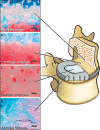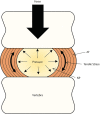Pathomechanism and Biomechanics of Degenerative Disc Disease: Features of Healthy and Degenerated Discs
- PMID: 34376493
- PMCID: PMC8092938
- DOI: 10.14444/8052
Pathomechanism and Biomechanics of Degenerative Disc Disease: Features of Healthy and Degenerated Discs
Abstract
The human intervertebral disc (IVD) is a complex organ composed of fibrous and cartilaginous connective tissues, and it serves as a boundary between 2 adjacent vertebrae. It provides a limited range of motion in the torso as well as stability during axial compression, rotation, and bending. Adult IVDs have poor innate healing potential due to low vascularity and cellularity. Degenerative disc disease (DDD) generally arises from the disruption of the homeostasis maintained by the structures of the IVD, and genetic and environmental factors can accelerate the progression of the disease. Impaired cell metabolism due to pH alteration and poor nutrition may lead to autophagy and disruption of the homeostasis within the IVD and thus plays a key role in DDD etiology. To develop regenerative therapies for degenerated discs, future studies must aim to restore both anatomical and biomechanical properties of the IVDs. The objective of this review is to give a detailed overview about anatomical, radiological, and biomechanical features of the IVDs as well as discuss the structural and functional changes that occur during the degeneration process.
Keywords: back pain; biomechanics; degenerative disc disease; intervertebral disc; low back pain; lumbar disc herniation; pathophysiology.
This manuscript is generously published free of charge by ISASS, the International Society for the Advancement of Spine Surgery. Copyright © 2021 ISASS.
Conflict of interest statement
Figures









References
-
- Hoy D, March L, Brooks P, et al. The global burden of low back pain: estimates from the Global Burden of Disease 2010 study. Ann Rheum Dis. 2014;73(6):968–974. - PubMed
-
- Hoy D, Brooks P, Blyth F, Buchbinder R. The epidemiology of low back pain. Best Prac Res Cl Rh. 2010;24(6):769–781. - PubMed
-
- Hooten WM, Cohen SP. Evaluation and treatment of low back pain: a clinically focused review for primary care specialists. Mayo Clin Proc. 2015;90(12):1699–1718. - PubMed
-
- Anderson DG, Tannoury C. Molecular pathogenic factors in symptomatic disc degeneration. Spine J. 2005;5(suppl 6):260s–266s. - PubMed
LinkOut - more resources
Full Text Sources
Research Materials
